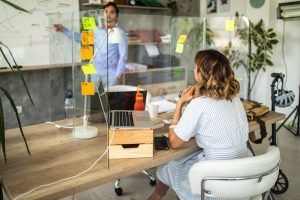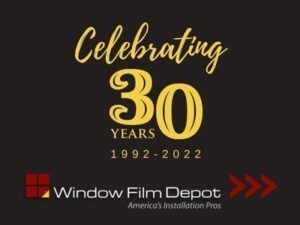 Sustainability is not simply about the 3 R’s: Reduce, Reuse, Recycle, but also about human sustainability. A workplace that supports occupant comfort and human well-being allows employees to do their best work. This holistic sustainability can be achieved by incorporating environmental and human-centric elements, creating a truly sustainable workplace and a win-win scenario for the organization, the employee and the planet.
Sustainability is not simply about the 3 R’s: Reduce, Reuse, Recycle, but also about human sustainability. A workplace that supports occupant comfort and human well-being allows employees to do their best work. This holistic sustainability can be achieved by incorporating environmental and human-centric elements, creating a truly sustainable workplace and a win-win scenario for the organization, the employee and the planet.
Companies need a happy and effective workforce and the impact of COVID-19. The shift to work-from-home and the sudden empowerment of employees to choose where and when they can work all have accelerated the premise that workplaces are all about the people who work there. An investment in a sustainable workplace and a healthy work culture helps companies communicate to employees that they are valued.
A sustainable workplace builds pride, demonstrates trust and produces more engaged employees. Employers benefit from this performance and gain an actual competitive advantage.
With frictionless design, we approach the workspace in terms of active and passive design and many of these strategies make even more sense as we adjust to the pandemic world.
Investing in healthy features for your employees not only includes design and construction, but also policy and culture. The workplace is the physical headquarters of an organization’s community and culture. Indeed, this may be its most important attribute and the feeling that “something important happens here, and I am part of that” is a key part of a successful workplace. To define an organization’s culture, an effective workplace should amplify this feeling.
What contributes to employee comfort and why does it matter? If workers are distracted by the environment because it is too cold or too warm, they may lose focus. They may get up, move around and interrupt a coworker. Now two employees are distracted. While some collisions between employees are encouraged to promote problem-solving and creativity, it rarely occurs when one person was deep into focused work. Here is an opportunity to create, in an intentional way, settings that support both individual focused work and collaborative innovation.
We stress a goal of designing workplaces that send people home feeling better than when they arrived. We may not be able to eliminate stress from people’s jobs, but we can eliminate the distractions and peripheral stressors in the work environment—think of glare or noise or temperature—whatever people might worry about. Only then can employees focus on their highest value—their work. This is what it means to have a frictionless environment.
With frictionless design, we approach the workspace in terms of active and passive design and many of these strategies make even more sense as we adjust to the pandemic world. Passive design strategies include:
- Acoustical control in both solo focus zones and collaborative meeting spaces.
- Thermal comfort controls drafts and solar radiation.
- Light control prevents eye strain from glare and supports circadian rhythms, which can promote better sleep at night.
- Biophilic elements and views contribute to calming effects and a connection to nature.
- Ergonomic seating and furnishings promote physical comfort and reduces strain.
- Enhanced air and water quality reduce pathogen transmissions, improve employee engagement and increase individual health.
Active design strategies allow employees to choose—to opt in. The key is that employees choose healthier options and employers help through education. For example, when presented with a buffet of food options, people often select less-healthy choices, but if options include nutritional data, they more often select healthier food. Active design strategies include:
- Activity-based work allows employees to reduce stress by choosing where and how work happens.
- Fitness and activity encourage and amplify better individual health.
- Healthy food and drink choices promote overall well-being.
- Healthy sleep cycles prioritized through education and awareness.
An example to mark…
At HP Inc.’s 380,000-square-foot campus in suburban Houston, its stated goal was to create its own office of the future. Recognizing the value employees bring every day, the Houston Campus needed to amplify an existing and strong employee culture and advance their work. Greater employee wellness with an emphasis on sustainability was promoted through a theme of Planet, People and Communities, leading to the project achieving LEED ID+C Gold certification and WELL Building principles were integrated throughout the project.
The design replicated a fitness center and basketball court from HP’s former location, but went even further by introducing new features to celebrate the company, the culture and the work.
Centralized social hubs on each floor and a high-energy community-centric “Main Street” on the ground level were highlights, which included a Starbucks-style coffee shop, a technology café help desk, print center and product demonstration area, food hall, dining commons and conference center. All of the areas were designed to be multi-functional, accommodating work zones in concert with social and relaxation areas. This new Main Street provides a variety of work settings for both group and solo work, and employees can choose where to work based on the task at hand.
The office areas are designed to support employees’ work and eliminate distractions and stressors that interfere with their ability to be efficient and effective. HP employed an effective Occupant Survey to engage their community and prioritize elements to promote wellness. A number of features that bridged employee well-being and sustainability were uncovered and incorporated into the workplace, including:
- Internal stairs for easy access and connection between floors.
- Choice and agility to accommodate collaborative work, access amenities and utilize quiet/focus zones.
- Acoustical control for meeting and focus spaces to separate active and focus zones.
- Ergonomic control with personalized instruction. Sit-stand desks encourage activity throughout the day.
- An indoor walking path including mileage markers when Houston weather may not be conducive to outdoor activity.
- Natural light and views increased with automated motorized shades. All work settings have views and natural light and there was a conscious effort to eliminate dark, enclosed spaces including labs. Translucent film provides privacy and security when necessary and shades control glare.
- Biophilic design integrated to stimulate cognitive brain function and provide emotional balance to the stress of work, by connecting occupants to nature.
- Daylight-responsive dimming, a code-driven requirement in many jurisdictions, provides energy efficiency and ensures task lighting for work. Dimming eliminates distractions of binary on-off switching.
- Water-use reduction—an easy choice for conservation has a low impact on employee comfort, including shower rooms where it can be most impactful.
- Water quality testing ensures safe water to drink, and filtration supports employee confidence that the company has their best interests in mind.
- Demand-control ventilation in high-use meeting spaces with preset CO2 monitoring points trigger additional fresh air, improving the air quality by lowering CO2 levels to reduce cognitive function and sleepiness.
This year has seen a new focus on workspaces and what makes them effective. As employees have become empowered to work from home, the office must exhibit a sense of real safety, promote healthfulness and well-being, and truly be a compelling destination in order for it to keep its relevance.
____________________________________________________________
Stuart Harris is a principal and director of architecture and sustainability at PDR. He has over 30 years of experience designing workplaces.










 The 2024 virtual Men’s Round Table will be held Q4, 2024, date TBD.
The 2024 virtual Men’s Round Table will be held Q4, 2024, date TBD.












